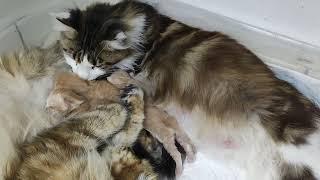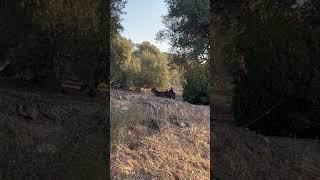Sometimes referred to as Batten disease, it is known to affect a large range of species. Download our free health checklist:
https://drive.google.com/file/d/1pq7_UKtCDuakJngevSRFcAmuVxbdZgpk/view?usp=sharing
Connect with us!
Website: https://www.puppyclassroom.co.uk
Email: team@puppyclassroom.co.uk
Facebook: https://www.facebook.com/PuppyClassroom-123163191715255
Neuronal ceroid lipofuscinoses are a group of neurodegenerative disorders divided into genetically distinct forms, but all causing accumulation of lipopigments in the body tissues.
Yellow lipopigments accumulate in body tissues mainly affecting the retina and nerve cells. The high levels cause membrane damage, damaging the mitochondria and lysosomes, causing progressive and permanent loss of motor and psychological ability. Accumulation of lipofuscin in the brain cells means they are unable to function properly resulting in neurologic signs.
There are 8 different genetic mutations to date and they can be further classified relating to the age of onset: Late infantile, juvenile and adult. NCL 10 American Bulldog Type differs from the other forms due to locomotion signs with no effect on vision.
Affected dogs begin to show signs from 9 months to 2 years, depending on breed. Symptoms include uncontrolled rhythmic head movements, ataxia, general weakness, behavioural changes, such as increased nervousness, decreased interactions with other dogs, severe dementia, sensitivity to loud noises, circling behaviour and increased inappropriate vocalisation. Eye examination reveals diffuse retinal thinning and severe retinal vessel degeneration progressing to complete blindness. The disease is progressive and unfortunately, most dogs are euthanised for humane reasons.
Mode of Inheritance:
Autosomal Recessive
Moderate-Severe Severity
Commonly Affected Breeds:
American Bulldog, American Bully, American Pit Bull Terrier, Australian Shepherd, Australian Kelpie, Australian Stumpy Tail Cattle Dog, Chihuahua, Chinese Crested Australian Cattle Dog, Dachshund, English Setter, Golden Retriever, Goldendoodle, Gordon Setter, Groodle, Irish Setter, Koolie, Labradoodle Retrodoodle, Miniature American Shepherd, Miniature Dachshund Long Hair, Miniature Dachshund Smooth Hair, Miniature Dachshund Wire Hair, Mixed Breed, New Zealand Heading Dog, Saluki, Smithfield, Standard Dachshund Long Hair, Standard Dachshund Smooth Hair, Standard Dachshund Wire Hair, Tibetan Terrier
Extra Information:
Ceroid lipofuscinosis has been diagnosed in the UK, USA and Australia in all border Collie lines. Prevalence of carriers in Australia is estimated at 5% which is approx 10 times the rate in the UK and USA. It is thought the prevalence of the disease in Australia is related to one dog that was imported before they were awarded the disease. Many Border Collies can be traced back to this line.
https://drive.google.com/file/d/1pq7_UKtCDuakJngevSRFcAmuVxbdZgpk/view?usp=sharing
Connect with us!
Website: https://www.puppyclassroom.co.uk
Email: team@puppyclassroom.co.uk
Facebook: https://www.facebook.com/PuppyClassroom-123163191715255
Neuronal ceroid lipofuscinoses are a group of neurodegenerative disorders divided into genetically distinct forms, but all causing accumulation of lipopigments in the body tissues.
Yellow lipopigments accumulate in body tissues mainly affecting the retina and nerve cells. The high levels cause membrane damage, damaging the mitochondria and lysosomes, causing progressive and permanent loss of motor and psychological ability. Accumulation of lipofuscin in the brain cells means they are unable to function properly resulting in neurologic signs.
There are 8 different genetic mutations to date and they can be further classified relating to the age of onset: Late infantile, juvenile and adult. NCL 10 American Bulldog Type differs from the other forms due to locomotion signs with no effect on vision.
Affected dogs begin to show signs from 9 months to 2 years, depending on breed. Symptoms include uncontrolled rhythmic head movements, ataxia, general weakness, behavioural changes, such as increased nervousness, decreased interactions with other dogs, severe dementia, sensitivity to loud noises, circling behaviour and increased inappropriate vocalisation. Eye examination reveals diffuse retinal thinning and severe retinal vessel degeneration progressing to complete blindness. The disease is progressive and unfortunately, most dogs are euthanised for humane reasons.
Mode of Inheritance:
Autosomal Recessive
Moderate-Severe Severity
Commonly Affected Breeds:
American Bulldog, American Bully, American Pit Bull Terrier, Australian Shepherd, Australian Kelpie, Australian Stumpy Tail Cattle Dog, Chihuahua, Chinese Crested Australian Cattle Dog, Dachshund, English Setter, Golden Retriever, Goldendoodle, Gordon Setter, Groodle, Irish Setter, Koolie, Labradoodle Retrodoodle, Miniature American Shepherd, Miniature Dachshund Long Hair, Miniature Dachshund Smooth Hair, Miniature Dachshund Wire Hair, Mixed Breed, New Zealand Heading Dog, Saluki, Smithfield, Standard Dachshund Long Hair, Standard Dachshund Smooth Hair, Standard Dachshund Wire Hair, Tibetan Terrier
Extra Information:
Ceroid lipofuscinosis has been diagnosed in the UK, USA and Australia in all border Collie lines. Prevalence of carriers in Australia is estimated at 5% which is approx 10 times the rate in the UK and USA. It is thought the prevalence of the disease in Australia is related to one dog that was imported before they were awarded the disease. Many Border Collies can be traced back to this line.
- Catégories
- Chats de Race American Wirehair















Commentaires